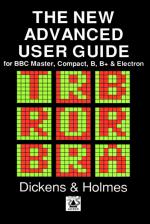
Electron User
 1st September 1988
1st September 1988
Categories: Review: Book
Author: Mark Smiddy
Publisher: Acornsoft/Adder
Machine: BBC/Electron
Published in Electron User 5.12
The original Advanced User Guide was first introduced four years ago, instantly gaining status as the standard text for informed users of the Electron and BBC Micro. At the time the Electron was Acorn's new baby, so new, that this frst guide barely skimmed the surface of this remarkable little computer.
In fact, the Electron has more in common with early versions of its big brother than many imagine. Much of this stems from the fact that the Electron's OS 1.0 is a debugged version of the BBC Micro's OS 1.2 and its BASIC is the greatly improved BBC BASIC 2.
The New Advanced User Guide attempts to be all things to all men and women. In a weighty 442 pages, it covers the deeper features of the BBC Micro models, Master, Compact, B, B+ and Electron.
It opens in typical style with full description of assembly language and the BASIC assembler. The full instruction set of the 6502 and its later derivatives - not used in the Electron - have been covered, each instruction given at least a page of explanation.
This makes the book an invaluable reference guide to 6502 assembly code in itself, although it does not aim to teach the language to a complete beginner. Having said that though, this is the sort of book that beginners would do well to avoid, lest they get bogged down by such heady subjects.
Following the assembly language section is an introduction to the Operating System and a very detailed set of memory maps.
Without doubt the most useful part of the new guide is the extended and revised coverage of the Operating System. It is in this particular area that the book specialises and where it really comes into its own.
The entire series of Operating Systems has been described in gret detail. To make this necessarily complex subject a little easier to understand, the guide has been divided into 24 sections, each covering part of the hardware and the Operating System calls provided to interface with it.
The design of the back cover allows it to fold inside the front of the book, this leaf containing a potted guide to the contents and summary of all of the Operating System routines, addresses and vectors.
One of the finest features of all Acorn machines is thei rupward compatibility with later designs. A precursor of this compatibility is that the programmer must use the Operating System to perform special functions at all times.
Acorn even goes as far as providing routines to access the hardware registers and Operating System variables. This means even if particular items change their locations in the overall memory map, properly written machine code will always work.
To this end the new guide provides a complete overview and comparison of the different Operating Systems now in use.
Surprisingly, software correctly written on an Electron should even work on Acorn's new Risc machine running the 6502 emulator, with little or no modification. I know of no other manufacturer who can boast that.
As far as the Electron is concerned, the real failing of this new text lies in its coverage of the hardware, where there are some startling differences between individual micros.
The design of the Electron centres around a large uncommitted logic array (ULA) designed specifically by Acorn.
This special chip handles all the hardware specific functions such as video, memory access, cassette interfacing and keyboard handling. In the other BBC Micros these functions are handled by a variety of complex chips.
There is hardly a mention of the Electron's hardware in the entire book. Others do fill this gap, but I feel that in a book of this price it is a glaring omission.
One of the few pieces of Electron hardware covered is the Plus 1's cartridge port, although this is only given a passing mention because it is essentially the same as the one used in the BBC Master.
The detailed information given should be of use to anyone wishing to design cartridge type hardware add-ons for their computer, a user port for instance.
Although the book is not as Electron-orientated as its cover might suggest, I found it to be a thoroughly good read and a worthwhile addition to my collection.
The text is clear and concise with diagrams thrown in where necessary. The author's style is authoritative without being at all condescending.
As good as it no doubt is, anyone who has already bought the original Advanced User Guide would be well advised to look long and hard at this one before buying.
Other Reviews Of The New Advanced User Guide For The BBC/Electron
The New Advanced User Guide (Acornsoft/Adder)
A review by Peter Rochford (Beebug)
The New Advanced User Guide (Acornsoft/Adder)
All The Ins And Outs


